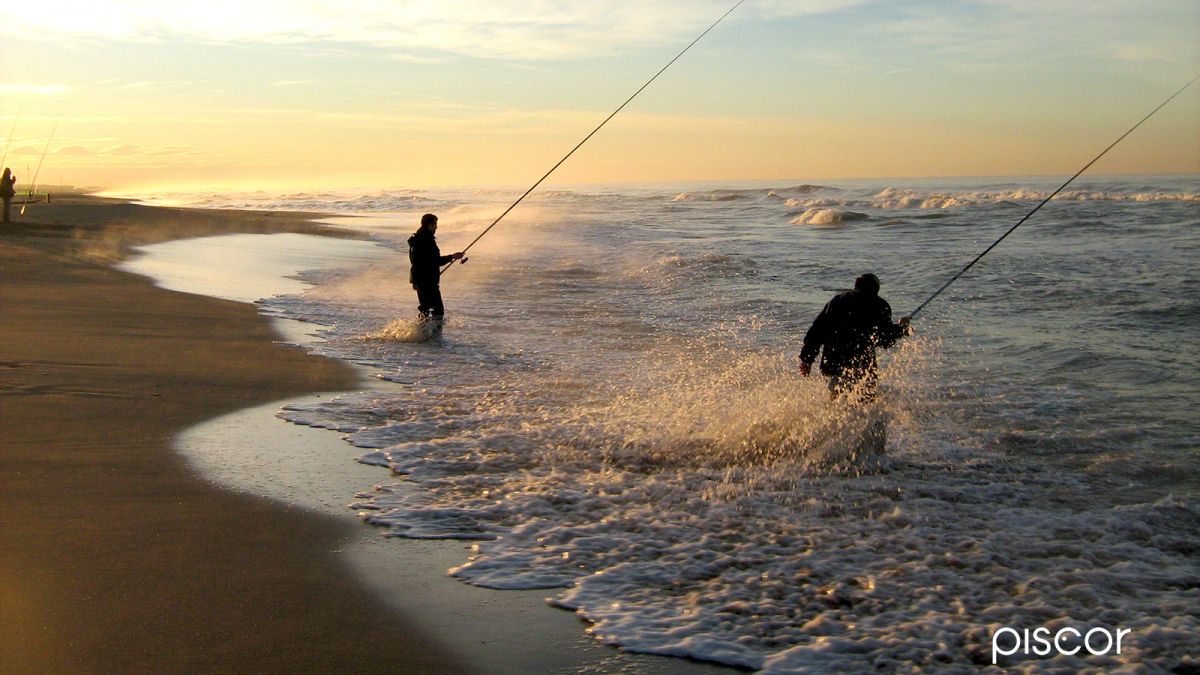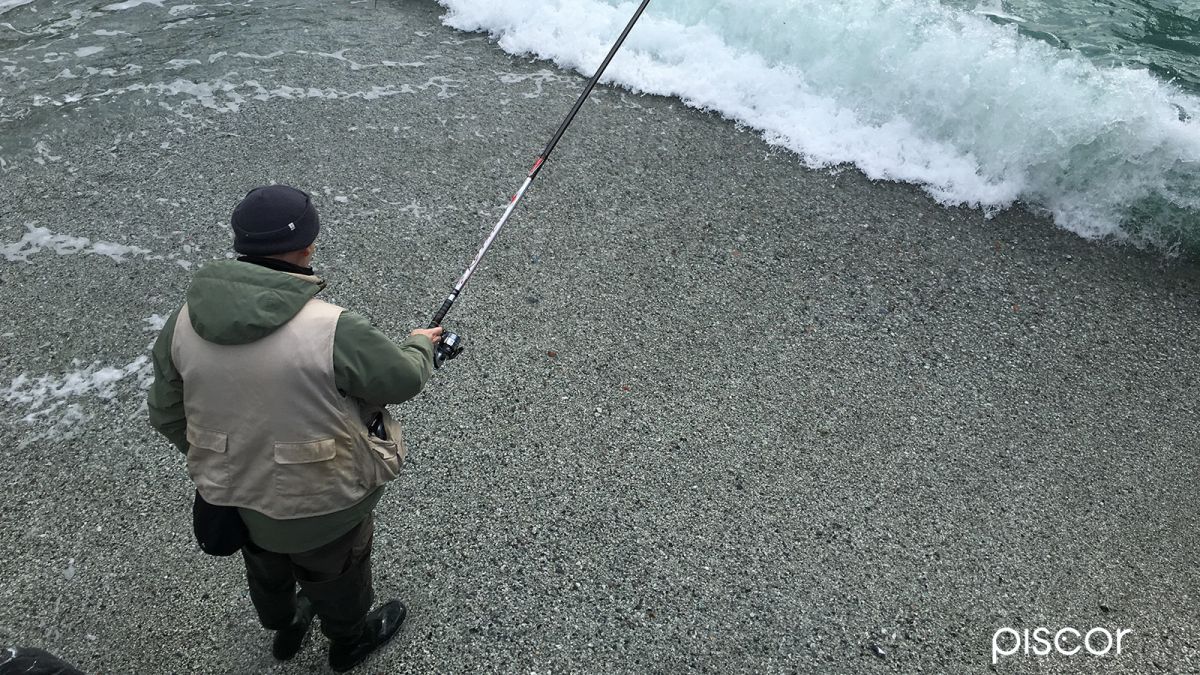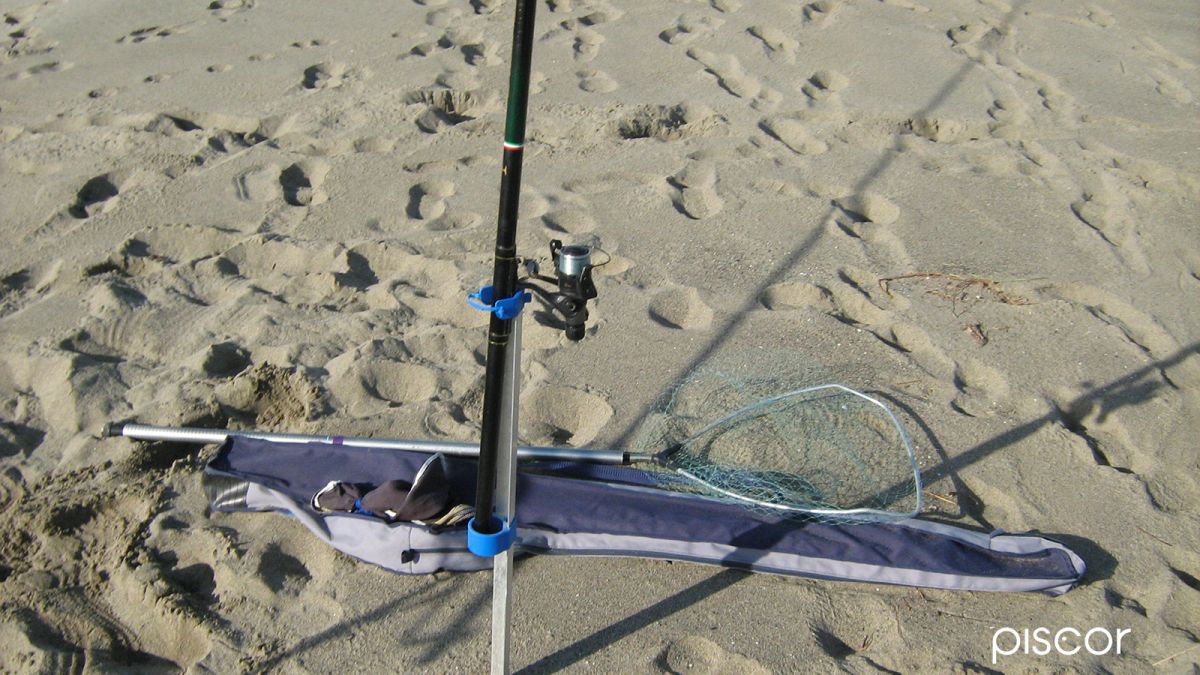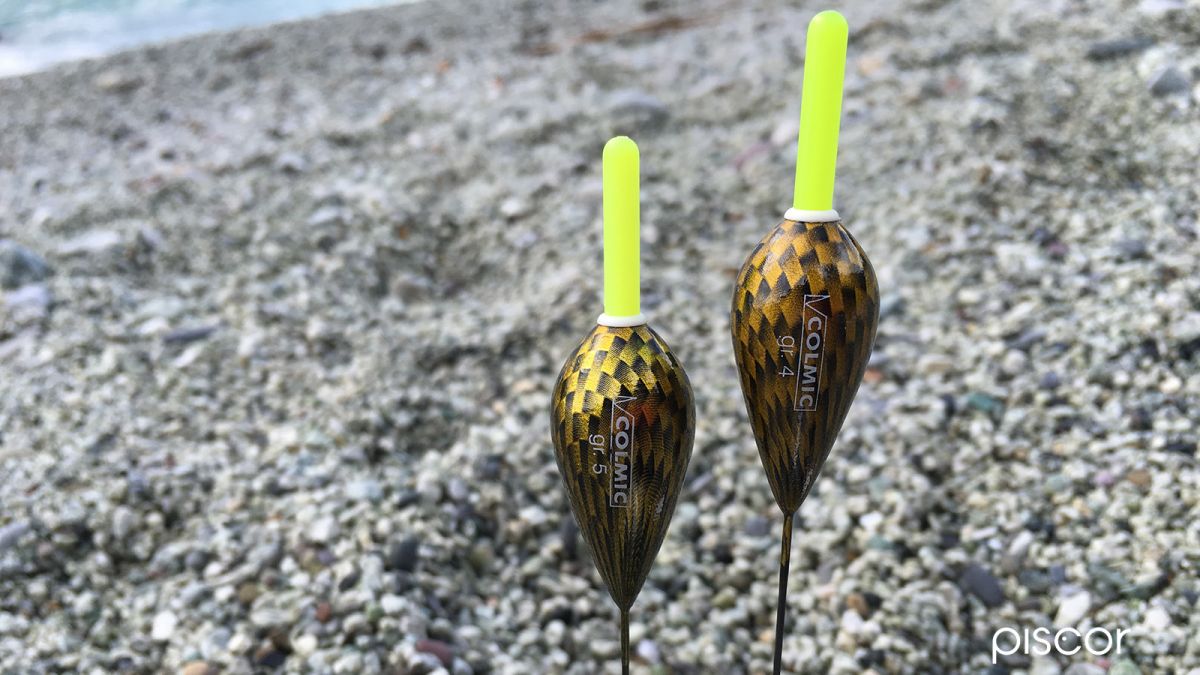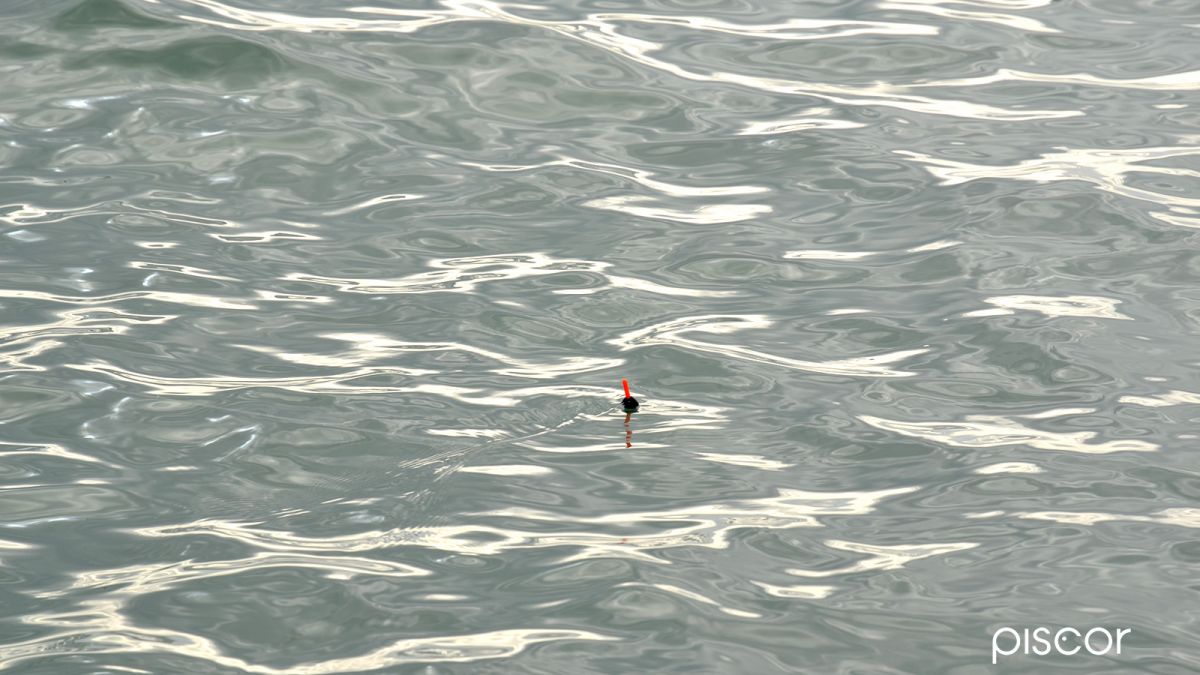Late autumn takes a very precise picture of the spot that is the subject of this article. The beach looks like a desert, an expanse of empty, damp sand that blends with the sea. A man, a fisherman with his trusty Bolo rod sails the shoreline in search of clues, certainties, answers ... with his waders retraces the coast several times, as an astronaut would do on the moon, looking for the right spot, and does not plant a flag, but his rod rest.
At that point the shoreline is not linear, but takes a semicircular shape, the current comes out homogeneously out to sea and merges with the orange shades of dawn. The search is over, it is time to launch, a new fishing adventure begins on the beach with the Bolo technique!
The beach is often considered as a particular place, dispersive, enigmatic, and devoid of references. It is thought that the fish are far away, scattered on the sand who knows where, hundreds of meters from the coast, but it is not so, sometimes they are there, right in front of our feet, near the backwash step or within the canal generated in sandy beaches.
The beach, therefore, is not the exclusive prerogative of specific techniques such as surf casting, but also with a simple Bolo rod, fishing a few meters from the shore you can get important results in terms of catches.
The latter only needs to be observed, understood and understood again, because it gives us signals that if interpreted correctly will allow us to perform an optimal fishing action and the satisfaction will certainly not take long to arrive.
There are different types of beaches, beaches characterized by shallow waters, others by deeper waters, sandy beaches and pebble beaches, mixed rock beaches with outcropping rocks, there are many and varied types, or rather the nuances of this environment. In addition to the many types are added other variables, you need to understand how to choose and deal with this spot, with calm sea or rough sea, day or night.
In this case we will deal specifically with only one specific type of beach, or we will talk about sandy beaches, characterized by the presence of canals and shallow waters, faced in conditions of rough sea or sufficiently formed. So, in summary, the main variables to be taken into account to understand how to deal with and set our fishing trip are mainly three: wave motion, grain size of the beach and morphology of the same.
Wave motion
Looking at the factors listed above, we can say that wave motion is of fundamental importance for the outcome of the catch. In this type of environment are to be discarded calm sea conditions, in fact shallow waters and stable conditions are not a winning combination in this type of spot.
In order for the sandy beach to become productive, we need sufficiently formed sea conditions, so that the relative currents can be generated in the canals parallel to the shoreline. This will allow the food that is under the sand to end up in suspension in the backwash, creating a trail of food inside the gully that will inevitably attract different types of fish, such as sea bass, gilthead sea bream and bream.
Experience teaches us that the optimal wave heights to best exercise this type of approach are those that range between 50 and 80 cm. These can be consulted on the various meteorological and marine sites present in the net, which now guarantee us a good reliability in this regard.
In autumn, the fishing action will take place during the day, the best times are from dawn to dusk, with particular attention to the middle hours.
Beaches
As previously mentioned, the granulometry of the beach plays a fundamental role, in fact, in sandy beaches, being the latter characterized by very fine granulometry, we will have a greater degree of turbidity of the waters than those of pebbles.
We have also associated this type of beach with shallow water. Shallow water means depths ranging between 80 cm, found at the edges of the gullies, and the 2 meters scarce, point of greater depth, found right in the middle of the canal. In this type of environment, before choosing the fishing station, a careful analysis of the shoreline is a must.
We will walk along it trying to perceive some elements of discontinuity of the same. During our exploration we will have to look for the presence of sand tips near semicircular bends. These will not be difficult to identify to the eye of a careful look. The sand tip indicates a shallow seabed condition that will continue even underwater for several tens of meters.
The semicircular bend, on the other hand, distinguishes a different seabed, undoubtedly greater than the tip, which is highlighted in the form of a pit or canal. This is the best fishing spot on the beach, near which we will plant our rod rest picket. We will therefore fish inside the canal, more precisely within the flow of current that is generated at that point and departs from the shoreline. This is delimited respectively on the right and on the left by the two points of shallow water.
In sufficiently formed sea conditions, the identification of the canal is facilitated by the backwash, which in these precise points, generates the unmistakable swipes of foam at the exit. We will fish right inside them, in our eyes there will no longer be the sea as an immense and infinite expanse of water, there will only be canal, which must be seen by our eyes as many small "rivers", within which we will perform our fishing action.
If a canal is not productive, we just have to move on to the next one, a few dozen meters away, and do some sort of itinerant fishing. The height of the wave also meets us in order to facilitate the identification of the canals. In fact, at the points where the water will be shallower, the height of the wave will be greater, because the shallow water facilitates the formation of a larger juncture. At the canal, however, the height of the wave will be lower, because the deeper seabed limits the lever that the wave can generate, thus forming a juncture of lower intensity.
Therefore, the canal that tends to be in the middle between two wave crests of greater intensity and foaming becomes clearly visible in the water. As for the other three variables that we have yet to examine, we can say the following: the presence of a mouth of fresh water in the vicinity can undoubtedly be a positive factor, increasing the possibility of catching all those fish that are attracted by the typicality of these waters, especially sea bass and mullet.
The presence of sea weed, on the other hand, is a negative factor, as their massive presence could affect the fishing action, as well as the outcome of the catch due to the continuous disturbance of sea weed entanglement on our fishing setting.
The presence of organic debris more concentrated on the shoreline near a canal, rather than in another, instead, is a positive factor to be taken strongly into account, given that it translates into a greater amount of food at that point, which will consequently attract a greater number of fish.
After this important and necessary initial analysis, we now move on to go into more detail, focusing our attention on fishing lines, bait, equipment, and on the actual fishing action.
Equipment
For fishing from the beach we will use Bolo rod with a parabolic-progressive action and a length of 6-7 meters. The reel will be 2500-3000 size loaded with a good nylon of 0.16. On it we will insert a float in the shape of an inverted pear of 3-4 grams.
The rig will be a fluorocarbon of the length of an abundant meter of diameter oscillating between 0.12 and 0.14, ending with a bronzed hook of 14-16. The rig will be connected to the main line by a blood knot.
Between the latter and the float we will have a fairly open lead crown made up of smaller and more distant pellets towards the end, and larger and closer pellets as we approach the float. Near the blood knot we will crush a number 8 pellet, followed by another one of the same size at a distance of 50 cm. Then we will crush another one of the number 7 at a distance of 40 cm, then another one of the number 7 at a distance of 35 cm and so on, proceeding in this way with two dots per size, until we get to calibrate the float with a dot of the number 3.
Clearly the float will not be perfectly calibrated, otherwise it will tend to sink repeatedly, and then come back to the surface due to the effect of the waves, disturbing not a little the identification of our detector.
Bait & pasture
As bait and baiting we will use the classic maggot, the trigger will be quite full-bodied, with 3 larvae, of which the first will be primed to stocking, while the others will be just pinned on the narrowest part of the larva.
The baiting will be done by hand, directly under our feet, in a few centimeters of water. The backwash itself will swallow it up in the stream and lay it down along the fishing line even tens of meters away. A few handfuls of larvae, at regular intervals of about ten minutes, will be more than enough to generate a trail of continuous and inviting pasture.
Last tips
Fundamental to this type of fishing is the use of waders, unthinkable, in fact, would be able to fish without getting wet, because of the continuous breaking of the waves on the shoreline. Of undisputed help, this clothing will result during the phases of fording and hauling of the fish in the middle of the foaming of the undergrowth.
Before starting to fish we will go to probe the depth of the canal that is in front of us. Usually the depth varies between one meter and sixty, and two meters and fifty. Once we have taken the measurement of the seabed we will increase the bottom by a further one and fifty meters, so, given the geometry of our line, we will have the last two dots of the number 8 that will work in the ground, allowing the final to scratch near the bottom. From the beach, in fact, we can afford it, given the absence of handholds and strandings, thus managing to confuse the trap in the middle of the food in suspension within the current flow.
As far as the fishing action is concerned, we will literally go to rest the line under the tip of the rod, it will be the very force of the outgoing current that will spread our fishing apparatus towards the open sea, following the wake of the pasture.
The pass will take place with the bow of the reel open, the simple friction on the rings of the rod during the exit of the wire will allow us to make a slight retention that will allow us to lay the final and all the shoveled current making the action of the fishing apparatus very natural and inviting.
The most frequent prey in this type of fishing are sea bass, mullet, gilthead sea bream, and even bream, if nearby there is the presence of both natural and artificial reefs. Beach fishing with the Bolo rod is one of the most fascinating techniques of land fishing, less obvious references than on reefs, fish exclusively passing through.
Understanding and seizing the right moment, which can sometimes be so short and ephemeral make this a fishing true connoisseurs, but no one is born learned! Experience and perseverance will increase our technical baggage, and with it the awareness of what we will do and go to do, so never get discouraged, the challenge begins and when it comes to the capture important satisfaction will be indescribable.

